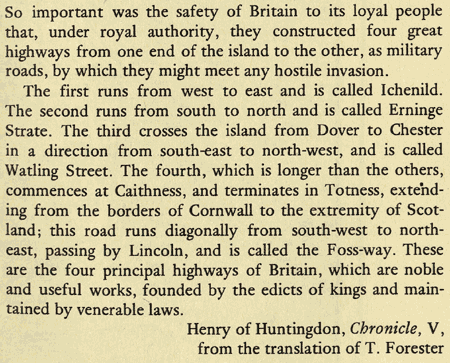The Romans obviously – well perhaps not. Terry Jones
in his Barbarians TV series said that the sack of Rome by the Gauls in 390
BC was a seminal event for the Romans. However, the British histories paint
a very different picture. The leader of the Gauls was Brennus and he was the
brother of the British king Belinus (and later succeeded him to the British
throne). The British had conquered, with their Gaulish allies much of the
rest of Gaul. However, before they set about sacking Rome, Britain had evidently
become peaceful and prosperous, perhaps not surprisingly, as it is a naturally
fertile country. In the Roman period, for example, it became the breadbasket
of Europe. The early British histories (Geoffrey of Monmouth the Kings of
Britain) claim that it was during this period that the four main roads of
Britain were built in stone and were straight – exactly like a Roman
road. Is
this credible? perhaps, it is certainly true that Roman roads in Britain have
two distinct phases – there is an early period where the roads were
dead straight whenever possible – excessively so – and the river
crossings were invariably fords – Deptford, Dartford, Crayford, Stratford,
etc. The later phase is characterised by far more ‘relaxed’ routes
made up from much shorter sections of straight road. The river crossings were
mainly bridges. A typical example of a later road is the Old Kent Road built
circa 100 AD. The most obvious reason for these two phases is that the first
phase was built by the Roman army as part of the invasion – the straightness
a type of propaganda to impress the natives, and fords being used to prevent
sabotage

The Four Major Roads
Henry of Huntingdon was a contemporary of Geoffrey of Monmouth
it is not clear to whom he attributes the building of these roads but these
do seem to be the same roads as described by Geoffrey of Monmouth. It should
be noted that the Icknield Way, as it is now called, is considerd
to be pre-Roman.
The Romans however, did
not claim to have built these four major roads of Britain, which all belong
to the first phase of building, at least no record exists. Of course, they
undoubtedly did built the majority of the Roman roads in Britain and probably
all of them. However, it is odd that there should be such a clear change from
the early phase to the later phase in such a relatively short time. The Old
Kent Road which is undoubtedly Roman and a second phase road, replaces an
earlier road which ran dead straight from New Cross Gate in south London to
the ford at Westminster. It is clear from other evidence that major changes
were made to the road system in the second phase of road building, which seems
largely to be overcoming the problems associated with the excessive straightness
of the first phase roads. If
these four roads were pre-Roman is would explain some anomalies. Why for instance
does Watling Street on its approach to the London area align with Westminster
and cross the Thames there – if London was founded by the Romans it
must have been as an afterthought. However, if Geoffrey of Monmouth is right
about the main roads being pre-Roman then London was already assigned one
of the four roads and Watling Street simply passed nearby because this was
the best route to serve it objectives.In
addition, there do seem to have been traces of an earlier road found by archaeologists
under the Fosse Way. There is no doubt either that the ancient Britons had
the ability to build decent roads from at least from the time of Stonehenge
some 4000 years ago as the Avenue, which surely must be contemporary with
it, is a sophisticated road and others have recently been found nearby by
Time Team. There should be no doubt either that there were pre-Roman roads
as Julius Caesar mentions them, he said the chariots preferred to fight off-road
before attacking the Romans and they could hardly be off road if there were
no roads. Then there is the place-name evidence, by and large, the more easily
understandable a place-name is the younger it is likely to be and because
Britain is such an ancient country (see climate
change) many of its place-names are no longer intelligible at all, having
been in circulation for so long. In contrast, place-names that came into being
in the Roman period, although about 2000 years old, seem mundane and modern
even. The Old Kent Road is a good example it simply describes what it is -
the old road to Kent, it was also known as Kentish Street. Yet no one is sure
what, for instance, Watling means and this does suggest some antiquity.If
these roads were built when it is claimed then it follows that since these
roads were built before the sacking of Rome then the Romans copied their roads
from the Britons, which would be a wonderful irony. However, the Romans nor
the British invented the ‘Roman’ road that honour goes to Carthage.
home
| missing Roman road | The
real Troy discovered | pre-Roman London
| Britain's forbidden history | contact
the author

